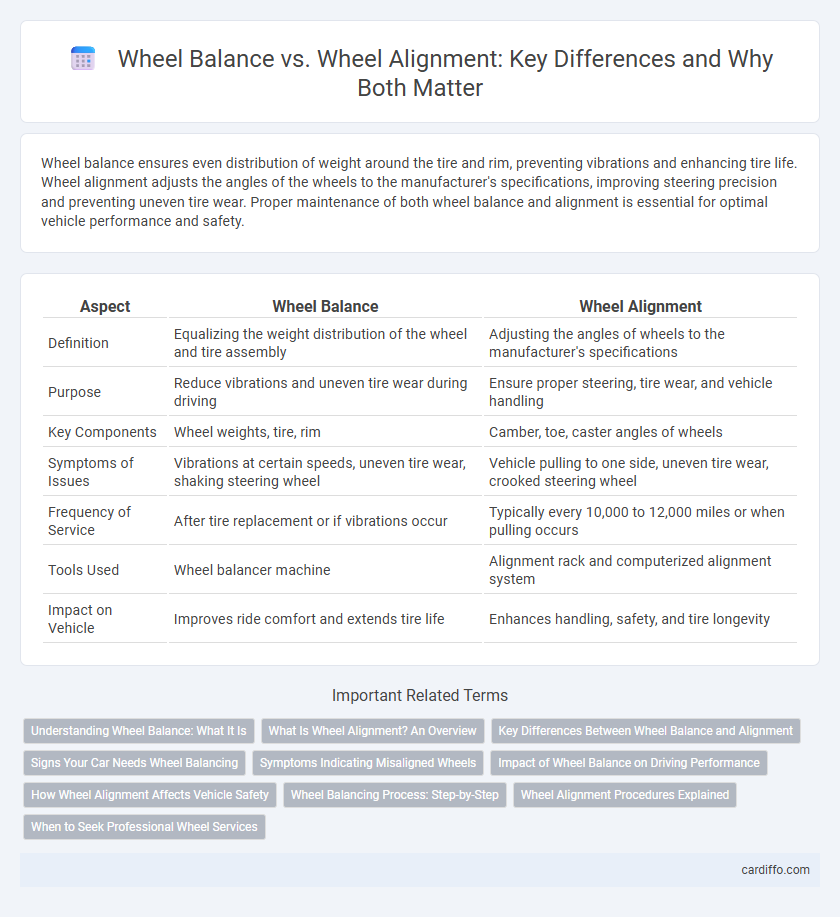Wheel balance ensures even distribution of weight around the tire and rim, preventing vibrations and enhancing tire life. Wheel alignment adjusts the angles of the wheels to the manufacturer's specifications, improving steering precision and preventing uneven tire wear. Proper maintenance of both wheel balance and alignment is essential for optimal vehicle performance and safety.
Table of Comparison
| Aspect | Wheel Balance | Wheel Alignment |
|---|---|---|
| Definition | Equalizing the weight distribution of the wheel and tire assembly | Adjusting the angles of wheels to the manufacturer's specifications |
| Purpose | Reduce vibrations and uneven tire wear during driving | Ensure proper steering, tire wear, and vehicle handling |
| Key Components | Wheel weights, tire, rim | Camber, toe, caster angles of wheels |
| Symptoms of Issues | Vibrations at certain speeds, uneven tire wear, shaking steering wheel | Vehicle pulling to one side, uneven tire wear, crooked steering wheel |
| Frequency of Service | After tire replacement or if vibrations occur | Typically every 10,000 to 12,000 miles or when pulling occurs |
| Tools Used | Wheel balancer machine | Alignment rack and computerized alignment system |
| Impact on Vehicle | Improves ride comfort and extends tire life | Enhances handling, safety, and tire longevity |
Understanding Wheel Balance: What It Is
Wheel balance involves evenly distributing the weight of a tire and wheel assembly to ensure smooth rotation and prevent vibrations at high speeds. Proper wheel balance reduces uneven tire wear and enhances vehicle stability by minimizing wobbling and steering wheel shake. It differs from wheel alignment, which adjusts the angles of the wheels to the manufacturer's specifications for optimal handling and tire longevity.
What Is Wheel Alignment? An Overview
Wheel alignment refers to the precise adjustment of a vehicle's suspension geometry to ensure the wheels are set to the manufacturer's specifications. Proper alignment optimizes tire contact with the road, improving handling, fuel efficiency, and tire longevity. Key alignment parameters include camber, toe, and caster angles, which influence vehicle stability and steering responsiveness.
Key Differences Between Wheel Balance and Alignment
Wheel balance refers to the even distribution of weight around a vehicle's tire and wheel assembly to prevent vibrations, while wheel alignment focuses on adjusting the angles of the wheels to ensure proper contact with the road and improve handling. Imbalanced wheels cause uneven tire wear and steering wheel vibration, whereas misaligned wheels lead to pulling, uneven tire tread wear, and reduced fuel efficiency. Proper maintenance of both wheel balance and alignment extends tire lifespan and enhances overall vehicle safety and performance.
Signs Your Car Needs Wheel Balancing
Uneven tire wear, vibration in the steering wheel at higher speeds, and pulling to one side while driving are clear signs your car needs wheel balancing. Imbalanced wheels cause uneven distribution of weight, leading to premature tire damage and reduced fuel efficiency. Timely wheel balancing improves vehicle stability, extends tire life, and enhances overall driving safety.
Symptoms Indicating Misaligned Wheels
Misaligned wheels often cause uneven tire wear, pulling to one side while driving, and a crooked steering wheel when driving straight. These symptoms indicate improper angles between the wheels, which can lead to decreased fuel efficiency and premature tire damage. Regular inspection and correction of wheel alignment help improve handling, safety, and overall vehicle performance.
Impact of Wheel Balance on Driving Performance
Proper wheel balance ensures even distribution of tire weight, reducing vibrations and enhancing driving comfort. Imbalanced wheels can cause uneven tire wear and strain on suspension components, negatively impacting vehicle stability and fuel efficiency. Maintaining accurate wheel balance is crucial for optimal handling, safety, and extended tire life.
How Wheel Alignment Affects Vehicle Safety
Proper wheel alignment ensures that tires make optimal contact with the road, enhancing vehicle stability and steering responsiveness. Misaligned wheels cause uneven tire wear and poor handling, increasing the risk of accidents due to compromised control. Maintaining accurate wheel alignment significantly improves braking performance and overall driving safety.
Wheel Balancing Process: Step-by-Step
Wheel balancing involves evenly distributing the weight of the tire and wheel assembly to prevent vibration and uneven tire wear. The process begins by mounting the wheel on a balancing machine that spins it to detect imbalance points. Weights are then strategically attached to the wheel rim to counteract heavy spots, ensuring smooth rotation and improved vehicle stability.
Wheel Alignment Procedures Explained
Wheel alignment involves adjusting the angles of a vehicle's wheels to the manufacturer's specifications, ensuring optimal tire contact with the road. Procedures include checking and correcting camber, toe, and caster angles using specialized alignment machines and sensors. Proper wheel alignment improves handling, reduces tire wear, and enhances overall driving safety.
When to Seek Professional Wheel Services
Seek professional wheel services when experiencing uneven tire wear, vibrations, or steering wheel pull during driving, as these symptoms indicate potential wheel balance or alignment issues. Wheel balancing is crucial if you notice vibrations at higher speeds, caused by uneven weight distribution around the tires. Wheel alignment should be addressed when the vehicle veers to one side or the steering wheel is off-center, ensuring proper tire contact and extending tire life.
Wheel Balance vs Wheel Alignment Infographic

 cardiffo.com
cardiffo.com